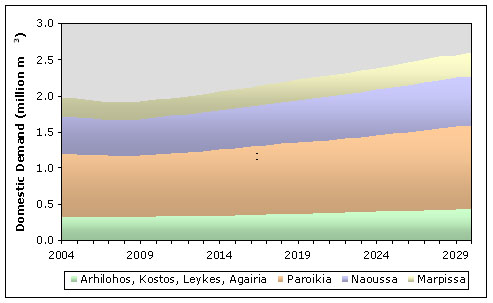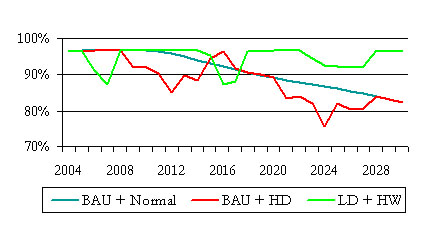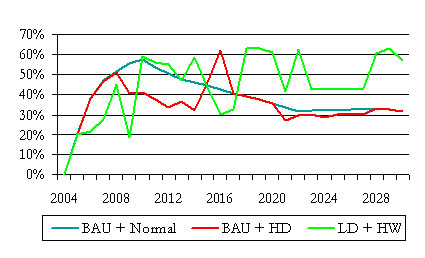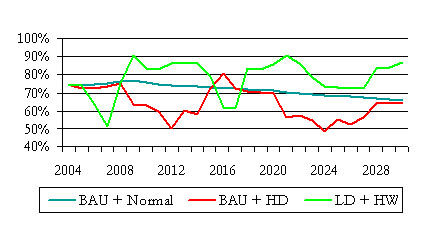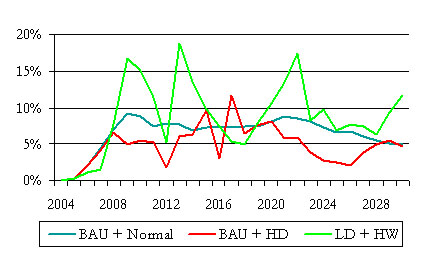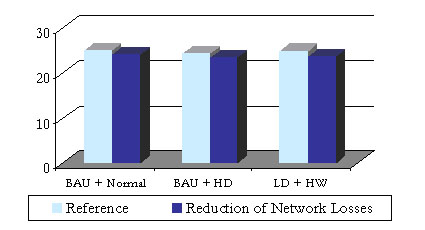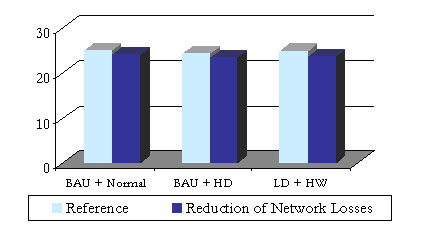
ISSUE 6 |
||||||||||||||||||||||||||||||||||||||||||||||||||||||||||||||||||||||
|
|
|||||||||||||||||||||||||||||||||||||||||||||||||||||||||||||||||||||
Option results |
||||||||||||||||||||||||||||||||||||||||||||||||||||||||||||||||||||||
|
Figure 1 presents the new demand for each municipal department under the BAU – Normal Scenario. Network replacements for Paroikia and Naoussa occur during the period 2005-2008, for Marpissa from 2005 to 2007 and for the other municipal departments in 2006, 2009 and 2012. Scheduling of replacements does not differ much for the other two examined scenarios. The implementation of the option can be delayed in the smaller municipal departments with the exception of Kostos, whose boreholes are used to supply the department of Paroikia.
Figure 1. Domestic demand per municipal department |
||||||||||||||||||||||||||||||||||||||||||||||||||||||||||||||||||||||
|
|
||||||||||||||||||||||||||||||||||||||||||||||||||||||||||||||||||||||
Effectiveness |
||||||||||||||||||||||||||||||||||||||||||||||||||||||||||||||||||||||
|
Reduction of losses through distribution network replacements shows a significant improvement in terms of both domestic and irrigation demand coverage. The reduction of losses results in improved efficiency in the supply of water towards the domestic use (Figure 2 and Figure 3). As with all measures targeted to promote conservation, some improvement in irrigation demand coverage is observed; this is due to the decline in domestic groundwater abstractions resulting in higher water availability for agricultural purposes (Figure 4 and Figure 5). Since no additional supply sources are introduced in the system, the effect of the option for both domestic and irrigation water use, decreases as domestic demand becomes higher due to population growth. This is not of course the case for the LD+HW scenario where, after 2015 demand stabilises. (Figure 3).
Figure 2. Percent demand coverage effectiveness of Reduction of Network
Losses
Figure 3. Percent Improvement of deficit in Domestic use
Figure 4. Percent demand coverage effectiveness of Reduction of Network
Losses
Figure 5. Percent Improvement of deficit in Irrigation use |
||||||||||||||||||||||||||||||||||||||||||||||||||||||||||||||||||||||
Direct and Environmental Costs |
||||||||||||||||||||||||||||||||||||||||||||||||||||||||||||||||||||||
|
Figure 6 presents the direct cost (expressed as the present value over the period 2004-2030) between the three scenarios after the implementation of the scheduled network replacements. An average reduction of direct costs of about 4% is common between all three scenarios. Additionally, in all three cases direct costs are smaller than those of the respective reference scenario, since the volume of water delivered to domestic uses is significantly lower. This reduction of annual operational costs adequately covers the expenses of the network replacements. The effect of the option is less significant under a high dry frequency; however the relatively low cost makes the measure a candidate for further examination during the strategy development phase.
Figure 6. Total direct cost difference of the Reduction of Network Losses option As the introduction of network improvements does not directly affect the level of abstraction, the environmental costs within each scenario show no significant variation, with the exception of the LD+HW scenario, where the preferential abstraction from less vulnerable aquifers (possible only under high availability conditions) means an improvement in overall environmental performance (Figure 7).
Figure 7. Total environmental cost difference of the Reduction of Network
Losses option |
||||||||||||||||||||||||||||||||||||||||||||||||||||||||||||||||||||||
